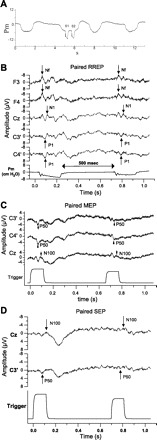Fig. 1.

A: mouth pressure with paired inspiratory occlusions (S1 and S2) for an individual subject. Both occlusions occurred within a single inspiratory cycle. Ordinate is the Pm change (in cmH2O), and abscissa is the time course (in s). B: the averaged respiratory-related evoked potentials (RREPs) elicited with paired occlusions for an individual subject. The interstimulus interval (ISI) was 500 ms. The Nf peaks are presented in the F3 and F4 channels, the N1 peak is presented in the Cz channel, and the P1 peaks are presented in the C3′ and C4′ channels. The bottom trace is the averaged Pm. C: the averaged mouth-evoked potential (MEP) trace elicited by paired air puff stimulation to the bilateral buccal surface of the cheeks. The P50 peak was presented in the C3′ and C4′ channels, and the N100 peak was identified in the Cz channel. The bottom trace is the trigger channel used as the reference for measuring the peak latencies. D: the averaged somatosensory-evoked potential (SEP) trace elicited by paired air puff stimulation to the right dorsal hand. The P50 peak was represented contralaterally in the C3′ channel, and the N100 peak was identified at the Cz channel. The bottom trace is the trigger channel used as the reference for measuring the peak latencies.
